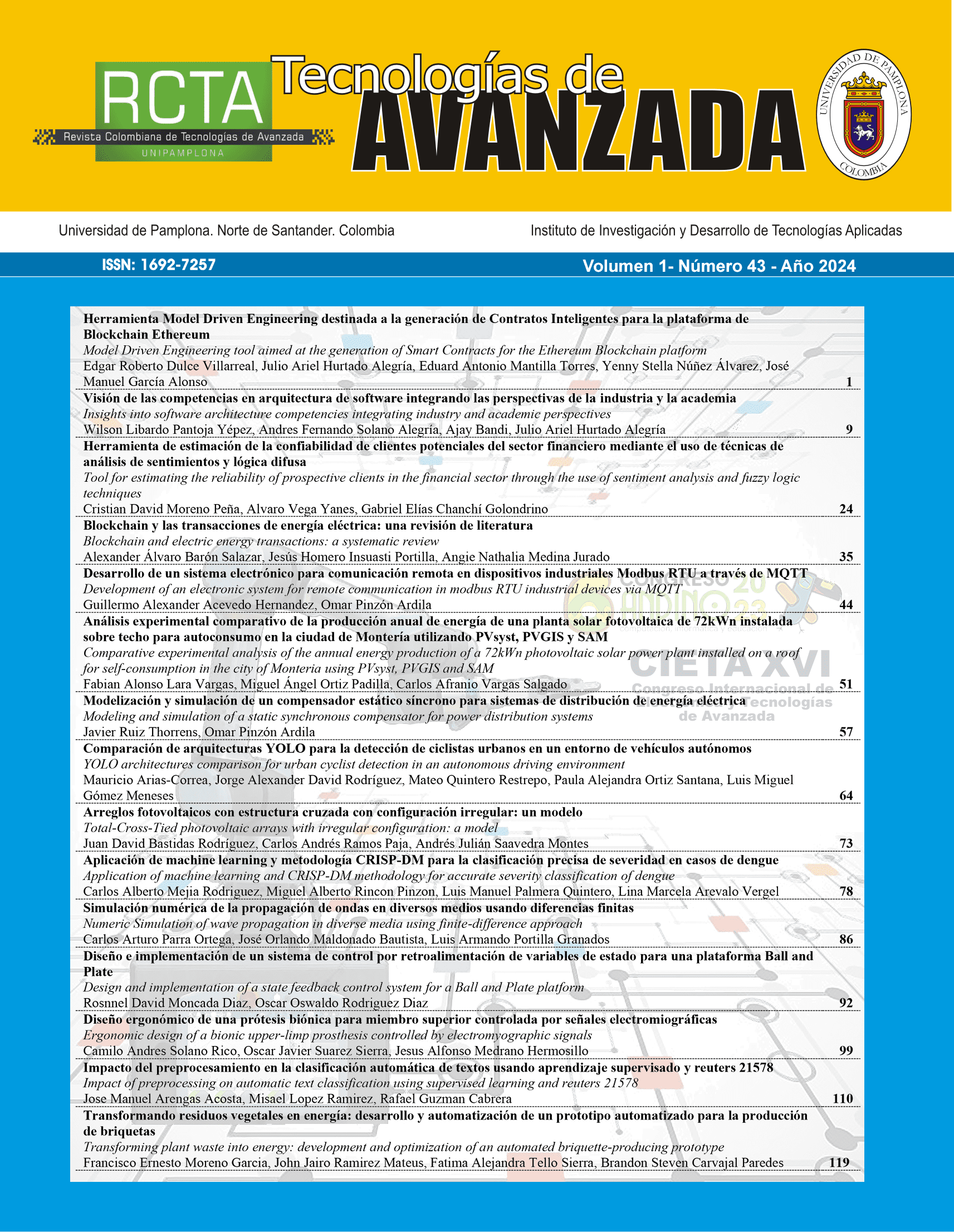Pattern for identifying the deployment points of artificial intelligence algorithms on the internet of things (IoT)
DOI:
https://doi.org/10.24054/rcta.v1i43.2912Keywords:
Internet of Things, Architectural Pattern, Web of Things, Software Engineering, Artificial IntelligenceAbstract
When developing IoT solutions, limitations in hardware and software capabilities arise. Additionally, the developer must choose the location within the ecosystem that best suits the development needs, having three possible processing locations: the network edge, the fog, and the cloud. This article proposes an architectural pattern that guides the selection of deployment point for AI algorithm-based applications based on the needs of the developed technological solution. The pattern was obtained using the Pratt's Iterative Research Pattern as a methodology. A real-world example was used, and the proposed step-by-step approach was applied to demonstrate the pattern's usefulness. It was concluded that the selection of processing location should consider the end-user needs and any limitations that may arise.
Downloads
References
P. Sethi and S. R. Sarangi, “Internet of Things: Architectures, Protocols, and Applications,” J. Electr. Comput. Eng., vol. 2017, p. 9324035, 2017, doi: 10.1155/2017/9324035. DOI: https://doi.org/10.1155/2017/9324035
G. Bai, L. Yan, L. Gu, Y. Guo, and X. Chen, “Context-aware usage control for web of things,” Secur. Commun. Networks, vol. 7, no. 12, pp. 2696–2712, 2014, doi: 10.1002/sec.424. DOI: https://doi.org/10.1002/sec.424
A. Wagner, J. L. V. Barbosa, and D. N. F. Barbosa, “A model for profile management applied to ubiquitous learning environments,” Expert Syst. Appl., vol. 41, no. 4 PART 2, pp. 2023–2034, Mar. 2014, doi: 10.1016/j.eswa.2013.08.098. DOI: https://doi.org/10.1016/j.eswa.2013.08.098
L. Yao, “A Propagation Model for Integrating Web of Things and Social Networks,” in Service-Oriented Computing - ICSOC 2011 Workshops, G. Pallis, M. Jmaiel, A. Charfi, S. Graupner, Y. Karabulut, S. Guinea, F. Rosenberg, Q. Z. Sheng, C. Pautasso, and S. Ben Mokhtar, Eds., Berlin, Heidelberg: Springer Berlin Heidelberg, 2012, pp. 233–238.
M. Niño Zambrano, “Interacción Semántica de Objetos en la Web de las Cosas,” 2013.
Z. Mahmood and M. Ramachandran, “Fog Computing: Concepts, Principles and Related Paradigms,” in Fog Computing: Concepts, Frameworks and Technologies, Z. Mahmood, Ed., Cham: Springer International Publishing, 2018, pp. 3–21. doi: 10.1007/978-3-319-94890-4_1. DOI: https://doi.org/10.1007/978-3-319-94890-4_1
N. Abbas, Y. Zhang, A. Taherkordi, and T. Skeie, “Mobile Edge Computing: A Survey,” IEEE Internet of Things Journal, vol. 5, no. 1. Institute of Electrical and Electronics Engineers Inc., pp. 450–465, Feb. 2018. doi: 10.1109/JIOT.2017.2750180. DOI: https://doi.org/10.1109/JIOT.2017.2750180
C. Mechalikh, H. Taktak, and F. Moussa, “A Scalable and Adaptive Tasks Orchestration Platform for IoT,” in 2019 15th International Wireless Communications Mobile Computing Conference (IWCMC), 2019, pp. 1557–1563. doi: 10.1109/IWCMC.2019.8766744. DOI: https://doi.org/10.1109/IWCMC.2019.8766744
B. Rababah, T. Alam, and R. Eskicioglu, “The Next Generation Internet of Things Architecture Towards Distributed Intelligence: Reviews, Applications, and Research Challenges,” SSRN Electron. J., 2020, doi: 10.2139/ssrn.3640136. DOI: https://doi.org/10.2139/ssrn.3640136
M. Aazam, S. Zeadally, and K. A. Harras, “Offloading in fog computing for IoT: Review, enabling technologies, and research opportunities,” Futur. Gener. Comput. Syst., vol. 87, pp. 278–289, Oct. 2018, doi: 10.1016/J.FUTURE.2018.04.057. DOI: https://doi.org/10.1016/j.future.2018.04.057
K. S. Pratt, “Design Patterns for Research Methods: Iterative Field Research,” in AAAI Spring Symp. Exp. Des. Real, 2009, pp. 1–7.
E. Gamma, R. Helm, R. Johnson, and J. Vlissides, “Design Patterns: Abstraction and Reuse of Object-Oriented Design,” 1993, pp. 406–431. doi: 10.1007/978-3-642-48354-7_15. DOI: https://doi.org/10.1007/3-540-47910-4_21
G. Bloom, B. Alsulami, E. Nwafor, and I. C. Bertolotti, “Design patterns for the industrial Internet of Things,” IEEE Int. Work. Fact. Commun. Syst. - Proceedings, WFCS, vol. 2018-June, pp. 1–10, Jul. 2018, doi: 10.1109/WFCS.2018.8402353. DOI: https://doi.org/10.1109/WFCS.2018.8402353
P. Chapman et al., “CRISP-DM 1.0: Step-by-step data mining guide,” 2000.
P. Avgeriou and U. Zdun, “Architectural Patterns Revisited - A Pattern Language.,” 2005, pp. 431–470.
H. Washizaki, S. Ogata, A. Hazeyama, T. Okubo, E. B. Fernandez, and N. Yoshioka, “Landscape of Architecture and Design Patterns for IoT Systems,” IEEE Internet Things J., vol. 7, no. 10, pp. 10091–10101, Oct. 2020, doi: 10.1109/JIOT.2020.3003528. DOI: https://doi.org/10.1109/JIOT.2020.3003528
A. Dounis, “Artificial intelligence for energy conservation in buildings,” Adv. Build. Energy Res., vol. 4, pp. 267–299, 2010, doi: 10.3763/aber.2009.0408. DOI: https://doi.org/10.3763/aber.2009.0408
J. Queiroz, P. Leitao, J. Barbosa, and E. Oliveira, “Distributing Intelligence among Cloud, Fog and Edge in Industrial Cyber-physical Systems,” in ICINCO, 2019. DOI: https://doi.org/10.5220/0007979404470454
“(PDF) Internet of Things (IoT): Definitions, Challenges, and Recent Research Directions.” https://www.researchgate.net/publication/320532203_Internet_of_Things_IoT_Definitions_Challenges_and_Recent_Research_Directions (accessed Nov. 27, 2022).
N. B. Ruparelia, Cloud computing. Mit Press, 2016. [Online]. Available: https://books.google.com.co/books?hl=es&lr=&id=umIsDAAAQBAJ&oi=fnd&pg=PR5&dq=Definition+of+Cloud+Computing&ots=k8BtuSpQ29&sig=FyIvnPN0V2lO12qQlPRrSekcaMk&redir_esc=y#v=onepage&q=Definition%20of%20CloudComputing&f=false
Additional Files
Published
How to Cite
Issue
Section
License
Copyright (c) 2024 Camilo Enrique Romero Parra, Carlos Alberto Cobos Lozada, Miguel Angel Niño Zambrano

This work is licensed under a Creative Commons Attribution-NonCommercial 4.0 International License.















